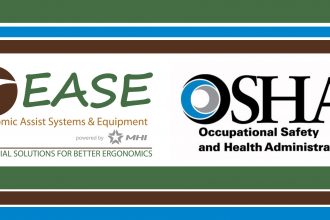Discover How Ergonomics Can Improve Worker Productivity And Retention

This article previously appeared in MHI Solutions Magazine, Volume 10, Issue 4.
Being able to operate equipment without being injured or too fatigued to do much of anything else for the rest of the day goes a long way in keeping employees happy—something particularly important in this era of the Great Resignation.
Members of MHI’s Industry Group EASE—Ergonomic Assist Systems and Equipment—know a thing or two about this.
EASE Council is a collaboration of manufacturers of ergonomic-focused equipment working together to provide resources, education materials and ultimately solutions to companies’ “ergonomic stressors,” said EASE Chair Amy Blueter, representing MHI member Kinetic Technologies LLC in Wickliffe, OH.
“Attracting and retaining skilled workers and top talent is at a critical point in manufacturing and especially in material handling,” Blueter said. “EASE members can help educate organizations and provide resources to those organizations that help improve ergonomics and increase safety and productivity.”
EASE members typically manufacture their equipment and therefore are able to supply ergonomic equipment specific to an organization’s needs, she explained. This can help attract and retain skilled labor and top talent by providing important safety and ergonomic benefits to their employees.
“Employees who have been working a job can stay at a job longer and with less physical stress if an ergonomic solution is introduced,” Blueter said. “In many organizations you may also see an increase in productivity by their employees as materials are easier to use and or are in a better location.”
Implementing ergonomic solutions and equipment can also reduce lost time accidents and workers’ compensation claims, she said—”keeping the folks who typically do those jobs, doing those jobs!”
To retain talent, companies certainly must promote safety, said EASE Secretary Scott Lackey, vice president of sales and marketing at MHI member Blickle USA based in Newnan, GA.
“Among EASE members, we want employees of our customers to go home with everything they brought to the office,” Lackey said.
There are many safety challenges that companies typically need to address, from simply trying to minimize repetition to complicated ergonomics when moving objects from point A to point B, he said. Such challenges increase then companies have no method to assist that ergonomic challenge.
“EASE members can come alongside customers to identify and evaluate ongoing operations and challenges, and then suggest improvements to make things safer or more ergonomic,” Lackey said. “It’s best to give recommendations during early-stage assessments of the facility, versus coming on only after an incident has occurred to remediate something.”
During early-stage assessments, EASE member representatives talk to everyone in the facility, including individuals interacting on an assembly line or driving vehicles. In particular, representatives spend a lot of time in the plant talking about ergonomics and safety issues.
“Companies have no idea how important of a topic this is with their employees,” Lackey said. “More and more people say they don’t mind working the hours they need to work, but they want the job to be easier and they don’t want to be exhausted. So sometimes the ergonomics application has nothing to do with safety, but everything to do with quality of life at the jobsite.”
EASE Vice Chair Kelly Wehner, president of MHI member BOSTONtec in Midland, MI, said that the group’s members want workers to be successful, to walk out at the end of the day feeling they’ve accomplished something—and that they leave work in the same physical condition as when they came in that morning.
“Employees spend an enormous amount of their lives at work, but the most important part of their lives is when they are home with their families, so we want to make sure they don’t feel spent so they can be with them emotionally and mentally as well,” Wehner said.
Workers should be able to remain injury-free and while they’ve done a hard day’s work, they’re not so fatigued that “all they want to do is go home, sit and watch TV,” she said.
“We want them to have the energy to be present and engaged with their families,” Wehner said.



